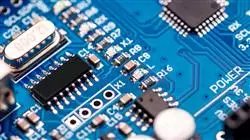University certificate
The world's largest faculty of information technology”
Introduction to the Program
Would you like to become the next Steve Jobs and revolutionize the computer industry with powerful and innovative computer systems? Opt for this Professional master’s degree and you will hold the keys to achieving it”

The invention of the Z1 as the first truly functional "modern" computer laid the foundations of an industry that, over the years, acquired a technical, complex, unique and innovative character, absolutely unthinkable for pioneers in this field such as Konrad Zuse or Alan Turing. From the launch of the first Colossus Mark to the successful commercialization of the Macintosh 128 K or the IBM PC with Windows 1.0 a year later, only 4 decades have passed, but these machines have gone from only reading encrypted communications to allowing their users to create documents, manage data and send e-mails.
Thanks to technological development, advances in computing and programming and the evolution of the IoT as the nerve center of collective communication of devices around the world, today, systems have reached a very high level of complexity, generating UX increasingly customized and adapted to the needs of society. No matter which way you look at it, information technology is present in all aspects of human life. For this reason, the role played by the professional in this field is fundamental and in high demand in today's market.
Based on this, TECH and its team of experts have developed a program that gathers the most exhaustive, comprehensive and innovative information in this sector, designed to serve as a guide for the graduate in their specialization. Over the course of 1,500 hours of diverse content, you will delve into the fundamentals of physics adapted to the field of computing, as well as the application of current technology and strategies to the design of software and applications for the different platforms and operating systems available. All this being 100% online and offering 12 months of theoretical and practical specialization with which you will not only adjust your profile to match the most demanding requirements of the industry, but in which you will find the keys to embark on the road to the new IT revolution that is about to arrive.
The perfect program to get you up to speed on the physical fundamentals of computer science and its application in the computing environment"
This Professional master’s degree in Systems Computing contains the most complete and up-to-date program on the market. Its most notable features are:
- The development of case studies presented by experts in Computer Engineering
- The graphic, schematic, and practical contents with which they are created, provide practical information on the disciplines that are essential for professional practice
- Practical exercises where self-assessment can be used to improve learning
- A special emphasis on innovative methodologies
- Theoretical lessons, questions to the expert, debate forums on controversial topics, and assignments for individual reflection
- Content that is accessible from any fixed or portable device with an internet connection
If you are looking to acquire the classical concepts of logical software design, this program will provide you with everything you need to handle Boolean algebra and the elements of memory”
The program’s teaching staff includes professionals from the sector who contribute their work experience to this program program, as well as renowned specialists from leading societies and prestigious universities.
The multimedia content, developed with the latest educational technology, will provide the professional with situated and contextual learning, i.e., a simulated environment that will provide immersive learning designed for real situations.
This program is designed around Problem-Based Learning, whereby the professional must try to resolve the different professional practice situations that arise during the academic year. For this purpose, the student will be assisted by an innovative interactive video system created by renowned and experienced experts.
In addition to a high volume of content to develop your knowledge of software, you will also work on computer and systems hardware"

TECH sets no limits: It is a program that you can access from wherever you want and through any device with an internet connection"
Why study at TECH?
TECH is the world’s largest online university. With an impressive catalog of more than 14,000 university programs available in 11 languages, it is positioned as a leader in employability, with a 99% job placement rate. In addition, it relies on an enormous faculty of more than 6,000 professors of the highest international renown.

Study at the world's largest online university and guarantee your professional success. The future starts at TECH”
The world’s best online university according to FORBES
The prestigious Forbes magazine, specialized in business and finance, has highlighted TECH as “the world's best online university” This is what they have recently stated in an article in their digital edition in which they echo the success story of this institution, “thanks to the academic offer it provides, the selection of its teaching staff, and an innovative learning method aimed at educating the professionals of the future”
A revolutionary study method, a cutting-edge faculty and a practical focus: the key to TECH's success.
The most complete study plans on the university scene
TECH offers the most complete study plans on the university scene, with syllabuses that cover fundamental concepts and, at the same time, the main scientific advances in their specific scientific areas. In addition, these programs are continuously being updated to guarantee students the academic vanguard and the most in-demand professional skills. In this way, the university's qualifications provide its graduates with a significant advantage to propel their careers to success.
TECH offers the most comprehensive and intensive study plans on the current university scene.
A world-class teaching staff
TECH's teaching staff is made up of more than 6,000 professors with the highest international recognition. Professors, researchers and top executives of multinational companies, including Isaiah Covington, performance coach of the Boston Celtics; Magda Romanska, principal investigator at Harvard MetaLAB; Ignacio Wistumba, chairman of the department of translational molecular pathology at MD Anderson Cancer Center; and D.W. Pine, creative director of TIME magazine, among others.
Internationally renowned experts, specialized in different branches of Health, Technology, Communication and Business, form part of the TECH faculty.
A unique learning method
TECH is the first university to use Relearning in all its programs. It is the best online learning methodology, accredited with international teaching quality certifications, provided by prestigious educational agencies. In addition, this disruptive educational model is complemented with the “Case Method”, thereby setting up a unique online teaching strategy. Innovative teaching resources are also implemented, including detailed videos, infographics and interactive summaries.
TECH combines Relearning and the Case Method in all its university programs to guarantee excellent theoretical and practical learning, studying whenever and wherever you want.
The world's largest online university
TECH is the world’s largest online university. We are the largest educational institution, with the best and widest online educational catalog, one hundred percent online and covering the vast majority of areas of knowledge. We offer a large selection of our own degrees and accredited online undergraduate and postgraduate degrees. In total, more than 14,000 university degrees, in eleven different languages, make us the largest educational largest in the world.
TECH has the world's most extensive catalog of academic and official programs, available in more than 11 languages.
Google Premier Partner
The American technology giant has awarded TECH the Google Google Premier Partner badge. This award, which is only available to 3% of the world's companies, highlights the efficient, flexible and tailored experience that this university provides to students. The recognition as a Google Premier Partner not only accredits the maximum rigor, performance and investment in TECH's digital infrastructures, but also places this university as one of the world's leading technology companies.
Google has positioned TECH in the top 3% of the world's most important technology companies by awarding it its Google Premier Partner badge.
The official online university of the NBA
TECH is the official online university of the NBA. Thanks to our agreement with the biggest league in basketball, we offer our students exclusive university programs, as well as a wide variety of educational resources focused on the business of the league and other areas of the sports industry. Each program is made up of a uniquely designed syllabus and features exceptional guest hosts: professionals with a distinguished sports background who will offer their expertise on the most relevant topics.
TECH has been selected by the NBA, the world's top basketball league, as its official online university.
The top-rated university by its students
Students have positioned TECH as the world's top-rated university on the main review websites, with a highest rating of 4.9 out of 5, obtained from more than 1,000 reviews. These results consolidate TECH as the benchmark university institution at an international level, reflecting the excellence and positive impact of its educational model.” reflecting the excellence and positive impact of its educational model.”
TECH is the world’s top-rated university by its students.
Leaders in employability
TECH has managed to become the leading university in employability. 99% of its students obtain jobs in the academic field they have studied, within one year of completing any of the university's programs. A similar number achieve immediate career enhancement. All this thanks to a study methodology that bases its effectiveness on the acquisition of practical skills, which are absolutely necessary for professional development.
99% of TECH graduates find a job within a year of completing their studies.
Professional Master's Degree in Computer Systems
.
Due to its particular characteristics, the IT area frequently undergoes modernization processes arising from new technological and methodological implementations in the sector, a fact that requires specialized professionals to be constantly updated in order to acquire skills in line with the development of today's working world. Understanding the continuous need for academic updating arising as a result of the processes of evolution in the area, in TECH Global University we have devised our Professional Master's Degree program in Computer Systems, designed to train the professional in the latest developments in the sector. Likewise, this postgraduate program pays special attention to current computing trends, and delves into the modernization of relevant concepts such as: the use of the main free software tools; modern particularities regarding computer networks, the network and link layer, and IP addressing; and symmetric and asymmetric cryptography applied to computer security.
Study a postgraduate degree in Computer Science online
.
Modern computing demands a high degree of preparation on the part of the specialized professional, both in terms of the approach to operating systems, as well as in relation to the integration of business information systems. In our Professional Master's Degree program you will access an academic process based on the strengthening of skills and knowledge essential for the development of modern computing tasks. In this way, the professional's knowledge is updated in aspects such as: the fundamentals of operating system interlocking, its prevention and timely avoidance; the role of emerging technologies applied to the service of computing; and the knowledge of the different types of malware and possible solutions to these.







